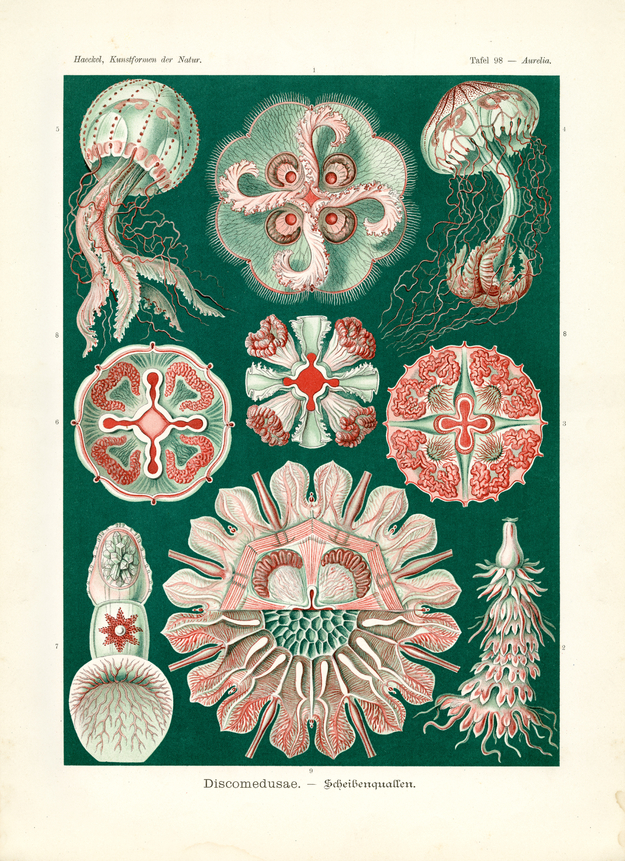Banner-mouthed disc-medusas’ illustrated on this plate show the same regular radial structure as Semostomae presented on plate 8. The circular, gelatinous umbrella (Umbrella) that is used as swimming organ shows the quadrangular mouth-opening (“mouth-cross”) in the centre of its concave bottom side (Subumbrella). Four long arms emerging from its four corners (fig. 5) are often banner-shaped and determine the radiants of the first order (Perradia). Mouth-arms regularly alternate with the four sexual glands or Gonads that are always found in the radiants of second order (Interradia, fig. 1, 3, 6 and 8). Along their internal rim rest four bunches of flexible ‘stomach-threats’ or gastral filaments reaching freely into the stomach cavity and playing a part in digestion. Along the outer umbrella rim eight ‘sensing-buds’ (four perradial and four inerradial) are fixed; each ‘sensing-bud’ (Rhopalium) is composed of three distinct sense organs: a ‘smelling-pit’ or nose with brachiate folds at the base (in fig. 7 bottom); an eye in the center (a round or brachiate pigment body, usually with lens); at the free end (in fig. 7 top) an ovoid capsule containing lime crystals; it was earlier considered a ‘hearing-vesicle’, now understood as balancing organ (‘balance-vesicle’ or Statocyste). Eight ‘sensing-buds’ usually alternate with eight (or more) long, flexible ‘capturing-filaments’ or tentacles (in the radiants of third order, Adradiae). In between tentacles and Rhopalia originally 16 protruding rim-lopes along the umbrella rim are resting in the radiants of fourth order (Subradia, fig. 9).
Phylum of Cnidaria (Nesseltiere); - class of Acraspedae (Lappenquallen); - order of Discomedusae (Scheibenquallen); - suborder of Semostomae (Fahnenmündige).
Translation by VR Translators Bangalore English description following soon.
This is one of the 100 pop science biology illustrations that were published from 1899 – 1904 in Leipzig by Ernst Haeckel through Verlag des Bibliographischen Instituts.
We've scanned the original lithography at 1200dpi on the Epson A3 scanner of A3 scanner huren. You can download a 400dpi JPEG here.
